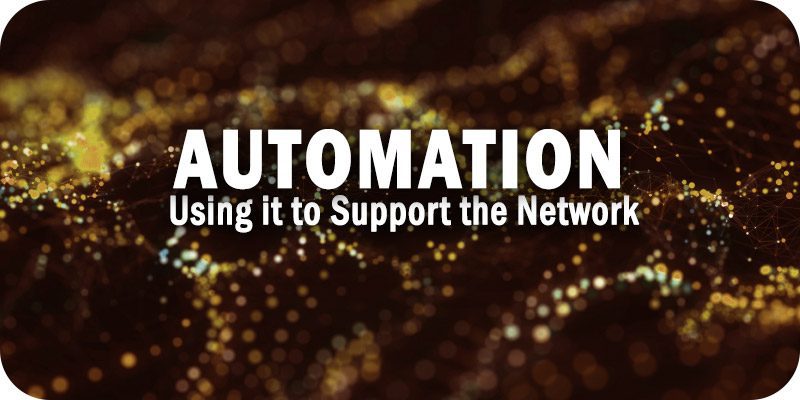Use Automation to Support the Network When You Don’t Own It


Solutions Review’s Expert Insights Series is a collection of contributed articles written by industry experts in enterprise software categories. Alex Hoff of Auvik guides us through using automation to support the networks your end-users are on, including the ones you don’t own.
 The rapid change to a hybrid remote workforce during the coronavirus pandemic caught most IT teams off guard. Suddenly they were tasked with new priorities, such as supporting video collaboration platforms, protecting data on BYOD personal devices, and ensuring access to remote hosting networks.
The rapid change to a hybrid remote workforce during the coronavirus pandemic caught most IT teams off guard. Suddenly they were tasked with new priorities, such as supporting video collaboration platforms, protecting data on BYOD personal devices, and ensuring access to remote hosting networks.
In this new environment, the top concern for CIOs is to provide a positive user experience for the hybrid workforce, but it can get complicated. The CIO faces two related challenges: First, how do you deal with the shift to remote work to support a distributed workforce? Second, how can you make legacy infrastructure and apps work seamlessly for the migration to a cloud-based, hybrid workplace?
Imagining the Future of Network Management
A worker who splits her time between the office and Starbucks still needs to do her job. No matter where she works, the IT team is accountable for ensuring that she has a quality end-user experience. This means IT managers must deploy new tools to troubleshoot problems regardless of where the user works. The solution to a weak Wi-Fi signal may be simply moving the worker closer to a weak access point – or notifying her that the problem is due to a Microsoft outage, not the weak Wi-Fi coverage at Starbucks.
This simple example addresses the underlying question: How do you support the network when you don’t own the network? The goal for IT should be to move away from managing a legacy network that someone else built and start building a next-generation network that IT can manage today. However, the gap in expectations can present a big challenge. Since IT does not own all the assets now, how can it be responsible for solving all the problems across the extended network? The ultimate prize involves completely automated remediation to ensure that everyone can do their jobs from everywhere.
Any SaaS-based application platform introduces new challenges for IT, such as where does all that employee and customer data live? And if there is a breach, how badly could we be harmed? For instance, even for a young Web-native company born in the cloud, HR still needs dependable systems to onboard new employees and store confidential information such as their Social Security number or compensation information. If someone needs to manually compare all the different vendors to solve the business problem of onboarding people in SaaS, that wastes too much employee time because the process is not automated.
The Urgent Need for Network Automation
The transition to a remote workforce has changed business practices forever, and along the way, it has created a growing need for automation to manage infrastructure and provide visibility into far-flung network assets. Network administrators used to maintain each switch in a data center as its own autonomous unit. That approach required human admins to perform upgrades one switch at a time, which was time-consuming and prone to human errors. Now network managers can create policies for software platforms to perform those tasks automatically.
This automated approach allows for upgrading 400 switches or more at the same time. In fact, this is the only solution for large enterprises that must manage 20,000+ switches, because their network admins would quickly become overwhelmed. Likewise, it is critical to developing a platform of common elements for asset discovery, such as all security assets. For IT operations, the mindset should be to not sweat the boring repetitive stuff and instead offload all those tasks to automated systems.
New data from Auvik’s 2023 Network IT Management Report showed that 30 percent of respondents said that network programming and automation were on their wish list. While just 8 percent utilize network automation today, 12 percent said they plan to add more automation over the next 12 months. There is also a risk of not automating network functions, such as the danger of overlooking potential security threats. When busy network admins are distracted or overwhelmed by other projects, they might miss a simple patch or software update, resulting in new vulnerabilities. In addition, network automation greatly increases productivity for the entire IT shop.
Final Thoughts
IT teams can save time and improve network performance by automating specific functions. Even in a heterogeneous environment, this means systems admins do not have to become experts in every aspect of the technology stack. After a problem gets discovered, the automated platform can send an alert to the team that the firewall version has reached end-of-life, for example, and then make the upgrade automatically. This approach allows the IT team to pursue more high-value tasks rather than performing routine system maintenance.
The gold standard for network management in today’s remote world is being able to proactively identify connectivity or efficiency problems that remote workers may experience before they themselves even realize it, and automatically remediate the issue. This journey begins by automating as many routine network management tasks as possible so that network managers can free up their time to focus on improving the end-user experience.




















